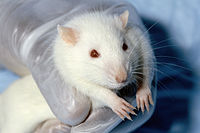Animal experiments
| Animal testing | |
|---|---|

|
|
| Description | Around 50–100 million vertebrate animals are used in experiments annually. |
| Subjects | Animal testing, science, medicine, animal welfare, animal rights, ethics |
Animal testing, also known as animal experimentation, animal research, and in vivo testing, is the use of non-human animals in experiments that seek to control the variables that affect the behavior or biological system under study. This approach can be contrasted with field studies in which animals are observed in their natural environments. Experimental research with animals is usually conducted in universities, medical schools, pharmaceutical companies, defense establishments, and commercial facilities that provide animal-testing services to industry. The focus of animal testing varies on a continuum from pure research, done with little regard to the uses to which understanding may be put, to applied research, which may focus on answering some question of great practical importance, such as finding a cure for a disease. Examples of applied research include testing, breeding, defense research, and toxicology, including cosmetics testing. In education, animal testing is sometimes a component of biology or psychology courses. The practice is regulated to varying degrees in different countries.
Worldwide it is estimated that the number of vertebrate animals—from zebrafish to non-human primates—ranges from the tens of millions to more than 100 million used annually. In the US in 2014, official statistics indicate that 834,453 vertebrates were used in research. In the EU, these species represent 93% of animals used in research. If the same was true in the US then the total number of animals used in research is estimated to be between 12 and 25 million. One estimate of mice and rats used in the US alone in 2001 was 80 million. In the EU in 2011, 11.5 million animals were used in research. Mice, rats, fish, amphibians and reptiles together account for over 85% of research animals.
Most animals are euthanized after being used in an experiment.Sources of laboratory animals vary between countries and species; most animals are purpose-bred, while a minority are caught in the wild or supplied by dealers who obtain them from auctions and pounds.
Supporters of the use of animals in experiments, such as the British Royal Society, argue that virtually every medical achievement in the 20th century relied on the use of animals in some way. The Institute for Laboratory Animal Research of the U.S. National Academy of Sciences has argued that animal research cannot be replaced by even sophisticated computer models, which are unable to deal with the extremely complex interactions between molecules, cells, tissues, organs, organisms, and the environment.Animal rights, and some animal welfare, organizations—such as PETA and BUAV—question the need for and legitimacy of animal testing, arguing that it is cruel and poorly regulated, that medical progress is actually held back by misleading animal models that cannot reliably predict effects in humans, that some of the tests are outdated, that the costs outweigh the benefits, or that animals have the intrinsic right not to be used or harmed in experimentation.
...
Wikipedia
